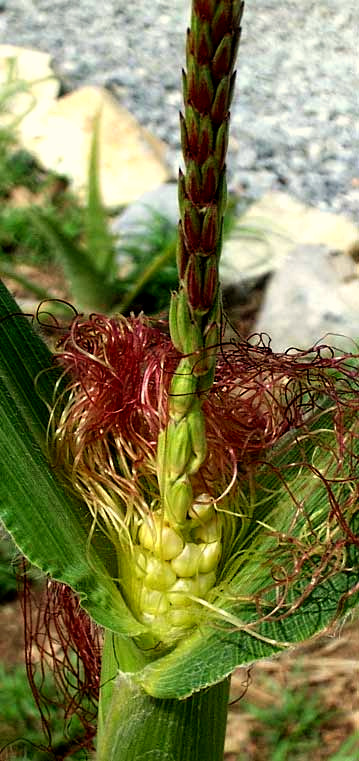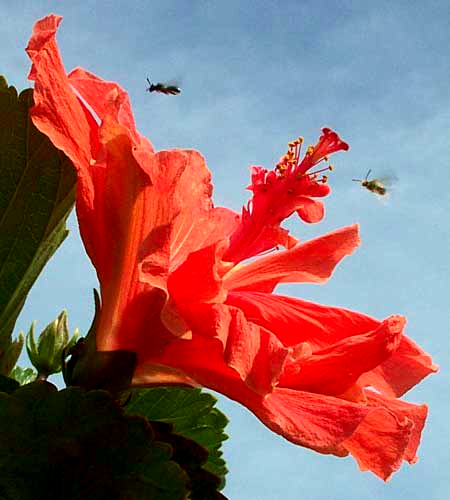Don Gonzalo does a good job planting ornamentals on the Reserve-office grounds and keeping things watered. This week on the path next to the Computer Room I noticed two plants that put me in a certain train of thought by the time I'd reached the path's end.
First there was a flowering corn plant with messed-up flowers. A normal corn plant is topped with an inflorescence of male flowers -- the tassel -- while spikes of female flowers (the future "ears," with the emerging "silks" being super-long styles) arise where the leafblades attach to the stalks. If you need a review of corn-flower anatomy, check out our Corn Flower Page .
However, this corn plant's tassel, instead of being branched the usual way, consisted of nothing but a single spike of male flowers pointing straight upward. Moreover, instead of female flowers being down below where ears of corn are supposed to develop later, a few female flowers appeared at the base of the single vertical spike -- where there should have been nothing but male flowers -- and there was nothing below! Below, you can see all this:

Not ten feet beyond the confused corn plant there was a hibiscus blossom also doing something abnormal. At http://www.backyardnature.net/fl_hibsc.htm you can see what a normal hibiscus flower looks like. Especially notice how a hibiscus flower's pollen-producing stamens arise from a cylinder surrounding the flower's style. Well, my path-hibiscus blossom's staminal column bore a few stamens at its top, but below them arose several items that were half stamen, half petal. In the picture below you can see these, runty, deformed, red petals arising where only yellow-anthered, pollen-producing stamens should be:

Actually, it's not uncommon to see such half-stamen, half-petal monstrosities in horticultural plants because many of our "double-blossomed" varieties have extra petals precisely because it's so easy for plant breeders to coax extra petals from stamens. In many garden rose blossoms you can see the same thing, an excellent example of which appears at the bottom of my Rose Page at http://www.backyardnature.net/fl_roses.htm.
Such abnormalities can appear so frequently because of this: We living things are sublimely complex and fragile electrochemical machines put together according to blueprints. Those blueprints are chromosomes carrying encoded information. And we all know that, with any complex set of instructions, having part of the instructions missing or illegible can lead to some awful problems.
So, here's the thought I ended up with after seeing the messed-up corn and hibiscus: Information encoded in our chromosomes is the most precious, complex stuff on Earth; yet it is profoundly fragile, and can be scrambled or lost very easily, with profound results.
And then: Of all the Universe's agents, nothing is more dangerous to the integrity of that information than chromosome-smashing radiation emitted from degrading, unstable nuclear material.
And nuclear material introduced into the environment today will be capable of killing living things and deranging genetic information in all forms of life for thousands of years to come.
It's good that finally we're talking about global warming. However, we mustn't lose sight of the fact that the coming wave of newly built nuclear-power plants, and the ever-growing list of countries with nuclear weapons, present much more of a long-term danger to Life on Earth than global warming.
For, after a few centuries of dealing with global warming, we'll still be human. But, once radioactive waste and war debris is dispersed throughout the Earth- ecosystem, who knows what monstrosities will emerge from US -- like female flowers in a corn plant's stunted tassel, like the hibiscus flower with parts that are neither this nor that? .